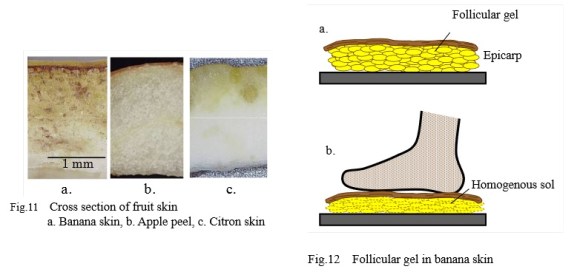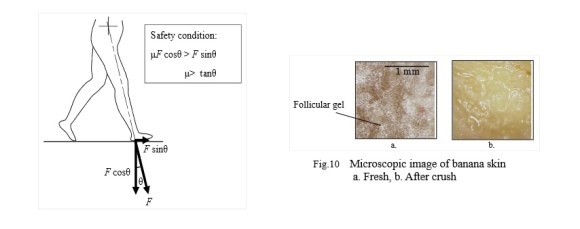
They feature so prominently in our Saturday morning cartoons and Charlie Chaplin movies that mankind has simply taken it as gospel that stepping on a banana peel will cause you to comically slip and fall with such a force that birds and stars will circle your head.
But did you know that until recently this was only a theory, unproven by a peer-reviewed scientific study? Thanks to the hard work done by Kiyoshi Mabuchi and his team at Kitasato University who were able to apply a frictional coefficient, we can unequivocally say that banana peels really are slippery when you step on them. Little wonder the group was awarded the 2014 Ig Nobel Prize in Physics.
At a ceremony held at Harvard University, Professor Mabuchi was present to accept his award, marking the eighth consecutive year that Japan was awarded an Ig Nobel Prize. When interviewed Professor Mabuchi said: “Banana peels being easy to slip on has been a self-evident thing, but I was able to scientifically prove it.”
The mechanics behind the banana peel’s legendary slipperiness are in tiny follicles on the inside skin. These little bubbles contain a gel-like substance that under normal circumstances isn’t terribly slippery. However, when pressure is applied, say from the foot of Wile E. Coyote, the membranes on these tiny follicles rupture and cause the gel to leak out and merge together creating a highly slick substance.
After examining the performance of this substance on various types of common flooring material, it was determined that a banana peel when stepped on with the inner side facing down will have a coefficient of friction (COF) of about 0.07, somewhere between a ski on snow and lubricated metal on metal. Although this information is useful in validating decades of comedic bits, Prof. Mabuchi is interested in the substance’s value as a potential lubricant for artificial limb joints.
So we salute the achievements of the team at Kitasato University and hope that some other research body in Japan can determine once and for all whether not realizing that you have just walked off the edge of a cliff will allow you to stay in the air.
Source: Improbable Research (English), Jijicom via Hachima Kiko (Japanese)
Professor Mabuchi and team’s report
Other Ig Nobel Prize winners for 2014
Neuroscience Prize
China/Canada
Jiangang Liu, Jun Li, Lu Feng, Ling Li, Jie Tian, and Kang Lee
For studying what happens in people’s brains when they see Jesus in a piece of toast
Psychology Prize
Australia/UK/USA
Peter K. Jonason, Amy Jones, and Minna Lyons
For building a case that people who stay up late are on average worse people than those who regularly wake up early in the morning
Public Health Prize
Czech Rep./Japan/USA/India
Jaroslav Flegr, Jan Havlíček, Jitka Hanušova-Lindova, David Hanauer, Naren Ramakrishnan and Lisa Seyfried
For looking into the potential dangers owning a cat might have on one’s mental health
Biology Prize
Czech Rep./Germany/Zambia
Vlastimil Hart, Petra Nováková, Erich Pascal Malkemper, Sabine Begall, Vladimír Hanzal, Miloš Ježek, Tomáš Kušta, Veronika Němcová, Jana Adámková, Kateřina Benediktová, Jaroslav Červený and Hynek Burda
For observing dogs’ preference to be aligned with Earth’s geomagnetic field when pooping or peeing
Art Prize
Italy
Marina de Tommaso, Michele Sardaro, and Paolo Livrea
For measuring the difference in pain sensitivity one has when being hit by a powerful laser and when looking at either a pretty or ugly painting
Economics Prize
Italy
National Institute of Statistics
For increasing the size of the national economy by including illegal business transactions between willing parties like prostitution or smuggling
Medicine Prize
USA/India
Ian Humphreys, Sonal Saraiya, Walter Belenky and James Dworkin
For treating nosebleeds by stuffing some cured pork up there
Arctic Science Award
Norway/Germany
Eigil Reimers and Sindre Eftestøl
For investigating how reindeer react to people dressed as polar bears
Nutrition Prize
Spain
Raquel Rubio, Anna Jofré, Belén Martín, Teresa Aymerich, and Margarita Garriga
For studying a method to ferment sausages using lactic acid bacteria from infant poop
Congratulations to all the winners!



 Osaka doctor wins Ig Nobel Prize for discovering kisses can reduce allergic reactions
Osaka doctor wins Ig Nobel Prize for discovering kisses can reduce allergic reactions Nobel Prize for Literature eludes Japan’s Haruki Murakami yet again, and he couldn’t care less
Nobel Prize for Literature eludes Japan’s Haruki Murakami yet again, and he couldn’t care less Kyoto University study finds that cats have interest in phsyics
Kyoto University study finds that cats have interest in phsyics Shikoku Island holds world landmark lookalike photography contest judged by AI
Shikoku Island holds world landmark lookalike photography contest judged by AI Nobel Prize-winner Shuji Nakamura to Japan’s young people: “Get out of Japan”
Nobel Prize-winner Shuji Nakamura to Japan’s young people: “Get out of Japan” Japanese ramen restaurants under pressure from new yen banknotes
Japanese ramen restaurants under pressure from new yen banknotes Pokémon Sleep camping suite and guestrooms coming to Tokyo Hyatt along with giant Snorlax burgers
Pokémon Sleep camping suite and guestrooms coming to Tokyo Hyatt along with giant Snorlax burgers Tokyo Tsukiji fish market site to be redeveloped with 50,000-seat stadium, hotel, shopping center
Tokyo Tsukiji fish market site to be redeveloped with 50,000-seat stadium, hotel, shopping center McDonald’s new Happy Meals offer up cute and practical Sanrio lifestyle goods
McDonald’s new Happy Meals offer up cute and practical Sanrio lifestyle goods Beautiful Red and Blue Star luxury trains set to be Japan’s new Hokkaido travel stars
Beautiful Red and Blue Star luxury trains set to be Japan’s new Hokkaido travel stars Sakura tree falls on man at Sannenzaka near Kiyomizu temple in Kyoto 【Breaking News】
Sakura tree falls on man at Sannenzaka near Kiyomizu temple in Kyoto 【Breaking News】 French Fries Bread in Tokyo’s Shibuya becomes a hit on social media
French Fries Bread in Tokyo’s Shibuya becomes a hit on social media We tried Korea’s way-too-big King Tonkatsu Burger at Lotteria 【Taste Test】
We tried Korea’s way-too-big King Tonkatsu Burger at Lotteria 【Taste Test】 Studio Ghibli releases new action figures featuring Nausicaä of the Valley of the Wind characters
Studio Ghibli releases new action figures featuring Nausicaä of the Valley of the Wind characters Is the new Shinkansen Train Desk ticket worth it?
Is the new Shinkansen Train Desk ticket worth it? All-you-can-drink Starbucks and amazing views part of Tokyo’s new 170 meter-high sky lounge
All-you-can-drink Starbucks and amazing views part of Tokyo’s new 170 meter-high sky lounge More foreign tourists than ever before in history visited Japan last month
More foreign tourists than ever before in history visited Japan last month Starbucks reopens at Shibuya Scramble Crossing with new look and design concept
Starbucks reopens at Shibuya Scramble Crossing with new look and design concept Studio Ghibli glasses cases let anime characters keep an eye on your spectacles
Studio Ghibli glasses cases let anime characters keep an eye on your spectacles New private rooms on Tokaido Shinkansen change the way we travel from Tokyo to Kyoto
New private rooms on Tokaido Shinkansen change the way we travel from Tokyo to Kyoto Beautiful Ghibli sealing wax kits let you create accessories and elegant letter decorations【Pics】
Beautiful Ghibli sealing wax kits let you create accessories and elegant letter decorations【Pics】 Studio Ghibli releases Kiki’s Delivery Service chocolate cake pouches in Japan
Studio Ghibli releases Kiki’s Delivery Service chocolate cake pouches in Japan New definition of “Japanese whiskey” goes into effect to prevent fakes from fooling overseas buyers
New definition of “Japanese whiskey” goes into effect to prevent fakes from fooling overseas buyers Our Japanese reporter visits Costco in the U.S., finds super American and very Japanese things
Our Japanese reporter visits Costco in the U.S., finds super American and very Japanese things Studio Ghibli unveils Mother’s Day gift set that captures the love in My Neighbour Totoro
Studio Ghibli unveils Mother’s Day gift set that captures the love in My Neighbour Totoro Domino’s Japan now sells…pizza ears?
Domino’s Japan now sells…pizza ears? New Japanese KitKat flavour stars Sanrio characters, including Hello Kitty
New Japanese KitKat flavour stars Sanrio characters, including Hello Kitty New Pokémon cakes let you eat your way through Pikachu and all the Eevee evolutions
New Pokémon cakes let you eat your way through Pikachu and all the Eevee evolutions Sales of Japan’s most convenient train ticket/shopping payment cards suspended indefinitely
Sales of Japan’s most convenient train ticket/shopping payment cards suspended indefinitely Sold-out Studio Ghibli desktop humidifiers are back so Totoro can help you through the dry season
Sold-out Studio Ghibli desktop humidifiers are back so Totoro can help you through the dry season Japanese government to make first change to romanization spelling rules since the 1950s
Japanese government to make first change to romanization spelling rules since the 1950s Ghibli founders Toshio Suzuki and Hayao Miyazaki contribute to Japanese whisky Totoro label design
Ghibli founders Toshio Suzuki and Hayao Miyazaki contribute to Japanese whisky Totoro label design Doraemon found buried at sea as scene from 1993 anime becomes real life【Photos】
Doraemon found buried at sea as scene from 1993 anime becomes real life【Photos】 Tokyo’s most famous Starbucks is closed
Tokyo’s most famous Starbucks is closed One Piece characters’ nationalities revealed, but fans have mixed opinions
One Piece characters’ nationalities revealed, but fans have mixed opinions We asked a Uniqlo employee what four things we should buy and their suggestions didn’t disappoint
We asked a Uniqlo employee what four things we should buy and their suggestions didn’t disappoint Princesses, fruits, and blacksmiths: Study reveals the 30 most unusual family names in Japan
Princesses, fruits, and blacksmiths: Study reveals the 30 most unusual family names in Japan Dole Japan awarding personalised Banana Trophies to 200 runners in this year’s Tokyo Marathon
Dole Japan awarding personalised Banana Trophies to 200 runners in this year’s Tokyo Marathon Japanese researchers learn how to grow hair follicles, and probably new hair
Japanese researchers learn how to grow hair follicles, and probably new hair The number of doctorate students in Japan is now almost half of what it was 17 years ago
The number of doctorate students in Japan is now almost half of what it was 17 years ago Balance of intelligence factors makes Japan the world’s smartest country, according to this list
Balance of intelligence factors makes Japan the world’s smartest country, according to this list Japanese constitution nominated for Nobel Peace Prize
Japanese constitution nominated for Nobel Peace Prize We test out a product that promises it will make cars obsolete: these goofy looking boots
We test out a product that promises it will make cars obsolete: these goofy looking boots This super-rare Japanese banana has edible skin!【Taste test】
This super-rare Japanese banana has edible skin!【Taste test】 We’re going bananas over these amazing Attack on Titan…bananas!【Photos】
We’re going bananas over these amazing Attack on Titan…bananas!【Photos】 Whoever made the science department PR video for Tohoku University deserves a raise【Video】
Whoever made the science department PR video for Tohoku University deserves a raise【Video】 Supermarket slip lawsuit ruling influenced by size and color of pumpkin tempura
Supermarket slip lawsuit ruling influenced by size and color of pumpkin tempura Hilarious terror ensues as contest with Japanese arcade UFO catcher ends in a tie 【Video】
Hilarious terror ensues as contest with Japanese arcade UFO catcher ends in a tie 【Video】 In the evolution of pens, a “banana pen” is the obvious next step
In the evolution of pens, a “banana pen” is the obvious next step Blackboard art contest produces entries that will take your breath away
Blackboard art contest produces entries that will take your breath away Uno Mario Kart is ready to take the action from the track to the cards with cool crossover rule
Uno Mario Kart is ready to take the action from the track to the cards with cool crossover rule Uniqlo Pokémon T-shirt grand prize-winner disqualified for violating contest rules
Uniqlo Pokémon T-shirt grand prize-winner disqualified for violating contest rules
Leave a Reply